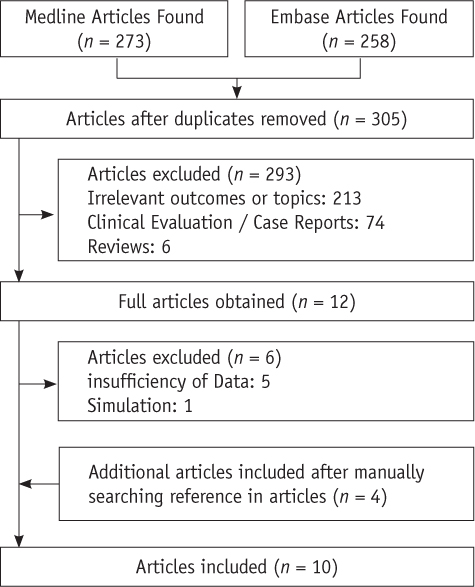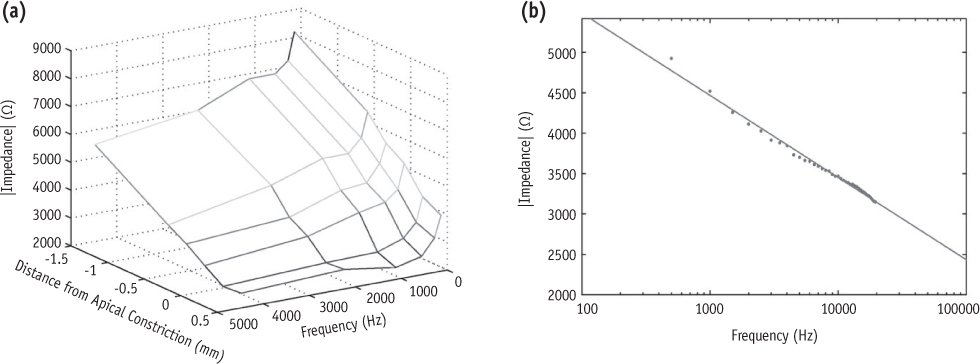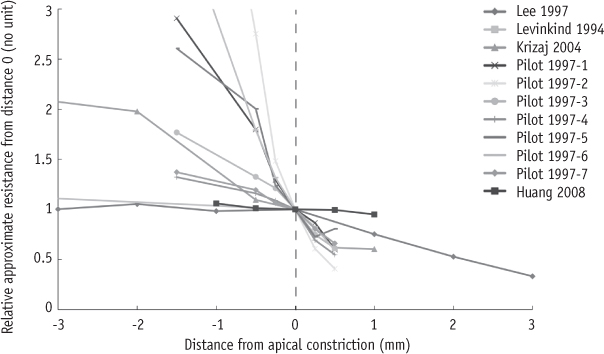Restor Dent Endod.
2015 May;40(2):113-122. 10.5395/rde.2015.40.2.113.
Evaluation of electrical impedance ratio measurements in accuracy of electronic apex locators
- Affiliations
-
- 1Biomedical Knowledge Engineering Laboratory, Seoul National University School of Dentistry and Dental Research Institute, Seoul, Korea.
- 2Department of Conservative Dentistry, Seoul National University School of Dentistry and Dental Research Institute, Seoul, Korea. chobh@snu.ac.kr
- KMID: 2148860
- DOI: http://doi.org/10.5395/rde.2015.40.2.113
Abstract
OBJECTIVES
The aim of this paper was evaluating the ratios of electrical impedance measurements reported in previous studies through a correlation analysis in order to explicit it as the contributing factor to the accuracy of electronic apex locator (EAL).
MATERIALS AND METHODS
The literature regarding electrical property measurements of EALs was screened using Medline and Embase. All data acquired were plotted to identify correlations between impedance and log-scaled frequency. The accuracy of the impedance ratio method used to detect the apical constriction (APC) in most EALs was evaluated using linear ramp function fitting. Changes of impedance ratios for various frequencies were evaluated for a variety of file positions.
RESULTS
Among the ten papers selected in the search process, the first-order equations between log-scaled frequency and impedance were in the negative direction. When the model for the ratios was assumed to be a linear ramp function, the ratio values decreased if the file went deeper and the average ratio values of the left and right horizontal zones were significantly different in 8 out of 9 studies. The APC was located within the interval of linear relation between the left and right horizontal zones of the linear ramp model.
CONCLUSIONS
Using the ratio method, the APC was located within a linear interval. Therefore, using the impedance ratio between electrical impedance measurements at different frequencies was a robust method for detection of the APC.
Figure
Cited by 1 articles
-
An in vitro evaluation of the accuracy of four electronic apex locators using stainless-steel and nickel-titanium hand files
Paras Mull Gehlot, Vinutha Manjunath, Mysore Krishnaswamy Manjunath
Restor Dent Endod. 2016;41(1):6-11. doi: 10.5395/rde.2016.41.1.6.
Reference
-
1. Ng YL, Mann V, Rahbaran S, Lewsey J, Gulabivala K. Outcome of primary root canal treatment: systematic review of the literature - Part 2. Influence of clinical factors. Int Endod J. 2008; 41:6–31.
Article2. Ng YL, Mann V, Rahbaran S, Lewsey J, Gulabivala K. Outcome of primary root canal treatment: systematic review of the literature - part 1. Effects of study characteristics on probability of success. Int Endod J. 2007; 40:921–939.
Article3. Smith CS, Setchell DJ, Harty FJ. Factors influencing the success of conventional root canal therapy-a five-year retrospective study. Int Endod J. 1993; 26:321–333.
Article4. ElAyouti A, Weiger R, Löst C. Frequency of overinstrumentation with an acceptable radiographic working length. J Endod. 2001; 27:49–52.
Article5. Kim E, Lee SJ. Electronic apex locator. Dent Clin North Am. 2004; 48:35–54.
Article6. Sunada I. New method for measuring the length of the root canal. J Dent Res. 1962; 41:375–387.
Article7. Inoue N, Skinner DH. A simple and accurate way to measuring root canal length. J Endod. 1985; 11:421–427.8. Kobayashi C, Suda H. New electronic canal measuring device based on the ratio method. J Endod. 1994; 20:111–114.
Article9. Nekoofar MH, Ghandi MM, Hayes SJ, Dummer PM. The fundamental operating principles of electronic root canal length measurement devices. Int Endod J. 2006; 39:595–609.
Article10. Gomes S, Oliver R, Macouzet C, Mercadé M, Roig M, Duran-Sindreu F. In vivo evaluation of the Raypex 5 by using different irrigants. J Endod. 2012; 38:1075–1077.11. Stöber EK, Duran-Sindreu F, Mercadé M, Vera J, Bueno R, Roig M. An evaluation of root ZX and iPex apex locators: an in vivo study. J Endod. 2011; 37:608–610.12. Stöber EK, de Ribot J, Mercadé M, Vera J, Bueno R, Roig M, Duran-Sindreu F. Evaluation of the Raypex 5 and the Mini Apex Locator: an in vivo study. J Endod. 2011; 37:1349–1352.13. Duran-Sindreu F, Stöber E, Mercadé M, Vera J, Garcia M, Bueno R, Roig M. Comparison of in vivo and in vitro readings when testing the accuracy of the Root ZX apex locator. J Endod. 2012; 38:236–239.
Article14. Meredith N, Gulabivala K. Electrical impedance measurements of root canal length. Endod Dent Traumatol. 1997; 13:126–131.
Article15. Krizaj D, Jan J, Valencic V. Modeling AC current conduction through a human tooth. Bioelectromagnetics. 2004; 25:185–195.
Article16. Al-bulushi A, Levinkind M, Flanagan M, Ng YL, Gulabivala K. Effect of canal preparation and residual root filling material on root impedance. Int Endod J. 2008; 41:892–904.
Article17. Levinkind M. A dental application of neural network computing: classification of complex electrical impedance measurements to aid root canal treatment. Neural Comput Applic. 1994; 2:209–215.
Article18. Huang JH, Yen SC, Lin CP. Impedance characteristics of mimic human tooth root canal and its equivalent circuit model. J Electrochem Soc. 2008; 155:51–56.
Article19. Pilot TF, Pitts DL. Determination of impedance changes at varying frequencies in relation to root canal file position and irrigant. J Endod. 1997; 23:719–724.
Article20. Perdikaris GA. Computer controlled systems: theory and applications. Netherlands: Kluwer Academic Publisher;1991. p. 116–118.21. Oishi A, Yoshioka T, Kobayashi C, Suda H. Electronic detection of root canal constrictions. J Endod. 2002; 28:361–364.
Article22. Lee SJ, Kim DW, Nam KC. Development of new frequency-dependent type apex locator: voltage difference compensating type. J Korean Acad Conserv Dent. 1997; 22:809–819.23. Gordon MP, Chandler NP. Electronic apex locators. Int Endod J. 2004; 37:425–437.
Article24. Nilsson JW, Riedel SA. Electric circuits. 5th ed. Reading, MA: Addison-Wesley;1996. p. 221–222.25. Nelson-Filho P, Romualdo PC, Bonifácio KC, Leonardo MR, Silva RA, Silva LA. Accuracy of the iPex multifrequency electronic apex locator in primary molars: an ex vivo study. Int Endod J. 2011; 44:303–306.
Article26. Rambo MV, Gamba HR, Ratzke AS, Schneider FK, Maia JM, Ramos CA. In vivo determination of the frequency response of the tooth root canal impedance versus distance from the apical foramen. Conf Proc IEEE Eng Med Biol Soc. 2007; 2007:570–573.27. Rambo MV, Gamba HR, Borba GB, Maia JM, Ramos CA. In vivo assessment of the impedance ratio method used in electronic foramen locators. Biomed Eng Online. 2010; 9:46.
Article28. Jan J, Krizaj D. Accuracy of root canal length determination with the impedance ratio method. Int Endod J. 2009; 42:819–826.
Article
- Full Text Links
- Actions
-
Cited
- CITED
-
- Close
- Share
- Similar articles
-
- Evaluating Accuracy according to the Evaluator and Equipment Using Electronic Apex Locators
- In vitro evaluation of accuracy and consistency of four different electronic apex locators
- An accuracy of the several electronic apex locators on the mesial root canal of the mandibular molar
- In vitro comparison of measurement accuracy in pre-enlarged and enlarged canals with four apex locators
- In vitro evaluation of the consistency of two electronic apex locators





